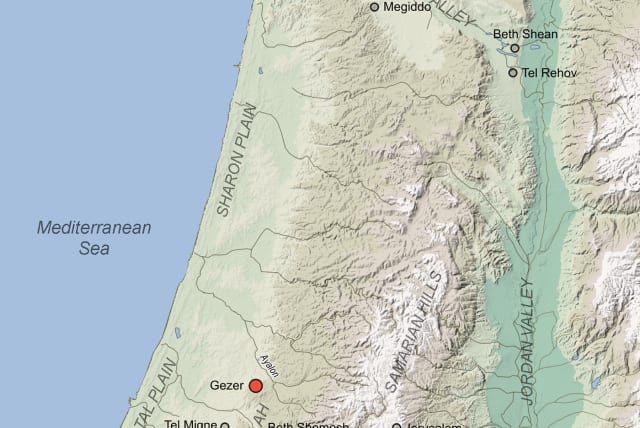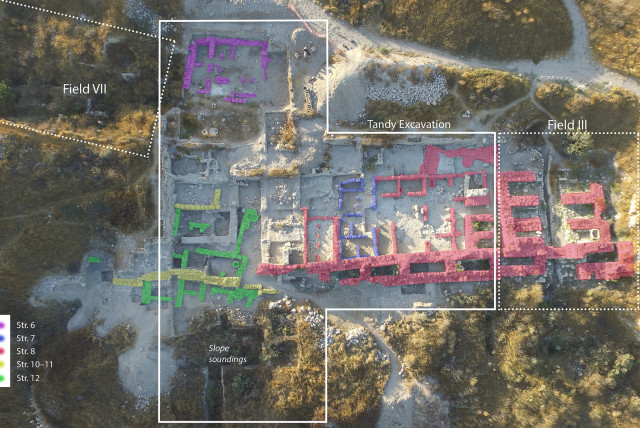Radiocarbon dating proves biblical accounts of the Israeli city of Gezer

New dates provided by Austrian archaeologists allow testing of proposed correlations between texts and archaeological remains
For scholars seeking to reconstruct the Bronze and Iron Age history of the southern Levant and explore the interplay between text and Gezer became a major fortified Canaanite city-state in the first half of the 2nd millennium BCE that was later destroyed by fire and rebuilt.
The importance of this intriguing site was due in part to the strategic position it held at the crossroads of the ancient coastal trade route linking Egypt with Syria, Anatolia and Mesopotamia and the road to Jerusalem and Jericho. The Bible mentions Joshua and Solomon in connection with Gezer, which today is a national park and an archaeological site in the foothills of the Judaean Mountains at the border of the Shfela region about midway between Jerusalem and Tel Aviv.
New dates provide detailed insights into the timing of events in the ancient city of Gezer, according to a study just published in the open-access journal PLOS ONE by Lyndelle Webster and colleagues of the Austrian Academy of Sciences and the Austrian Archaeological Institute in Vienna and colleagues. It is entitled “The chronology of Gezer from the end of the late bronze age to iron age II: A meeting point for radiocarbon, archaeology, Egyptology and the Bible.”
Webster is an archaeologist with a background in the natural sciences and engineering. Her research focuses on archaeometry – where she specializes in scientific dating methods and soil micromorphology. The Gezer excavations were sponsored by the Tandy Institute for Archaeology at Southwestern Baptist Theological Seminary.
“Gezer is mentioned in Egyptian, Assyrian and biblical texts – all of them sources that carry varying weight for reconstructing history. The Egyptian and Assyrian texts are contemporary with the events they describe and thus generally accepted as describing real events. The biblical texts were written centuries later and thus the historical realities behind them are less clear and more strongly debated,” the authors wrote.
“The results allow us for the first time to independently determine the site chronology, test the viability from a chronological perspective of proposed historical correlations, and contribute to debates on Philistine and Iron Age chronology,” the team wrote.
The ancient city of Gezer
Gezer was an ancient southern Levantine city associated with stories of power struggles and significant historical figures. It is also a rich archaeological site with abundant remains from the Bronze Age and the Iron Age remains that offer much potential for research into the daily lives of those who lived there.
Recent excavations at the site have uncovered a continuous stratigraphic sequence (stratigraphy is a branch of geology concerned with the study of rock layers and layering that is used mainly to examine sedimentary and layered volcanic rocks). This allows for detailed dating and the establishment of an absolute chronology for events at the site.
In this study, Webster and colleagues obtained 35 radiocarbon dates on organic materials – most of them seeds – from seven distinct stratigraphic layers at Gezer. These dates range from the 13th to the 9th centuries BCE, a time period that covers numerous significant changes in the city, including multiple destructive events, rebuilding episodes, and the fortification of the city. Some of these events have been proposed to be linked to certain stories from ancient texts.
The study provides a detailed dataset that can be used to test proposed correlations between the archaeological record and ancient texts. These dates suggest, for example, that the correlation of a certain destructive episode with the actions of the Pharaoh Merneptah is plausible, while the proposed link between another such episode and the campaign of Hazael is not. Ultimately, this new dataset provides an independent source of absolute dates that will allow researchers to better understand the events at Gezer and to place them in a regional perspective.
The biblical story of the Israelite conquest of Canaan under their leader Joshua mentions a certain “king of Gezer” (Joshua 10:33) who had gone to help his countrymen in Lachish, where he met his death. Gezer is listed in the Book of Joshua as a Levitical city, one of 10 allotted to the Levite children of Kehat (Joshua, chapter 21).
According to the Bible (1 Kings 9:15–16),which is the only source that mentions both Solomon and this particular event, the “sacking of Gezer” took place at the beginning of the 10th century BCE, when it was captured and burned down by an unnamed Egyptian pharaoh during his military campaign in Philistia. This anonymous Egyptian pharaoh then gave it to King Solomon as the dowry of his daughter, and the Jewish king rebuilt and fortified it.
The authors wrote that “The development of a radiocarbon-based chronology at Tel Gezer – a site with uniquely rich historical connections – illustrates the crucial role radiocarbon dating can and must play in reconstructing individual site histories, resolving long-running debates and testing possible correlations between archaeological remains and written sources.”
Jerusalem Post Store
`; document.getElementById("linkPremium").innerHTML = cont; var divWithLink = document.getElementById("premium-link"); if (divWithLink !== null && divWithLink !== 'undefined') { divWithLink.style.border = "solid 1px #cb0f3e"; divWithLink.style.textAlign = "center"; divWithLink.style.marginBottom = "15px"; divWithLink.style.marginTop = "15px"; divWithLink.style.width = "100%"; divWithLink.style.backgroundColor = "#122952"; divWithLink.style.color = "#ffffff"; divWithLink.style.lineHeight = "1.5"; } } (function (v, i) { });

